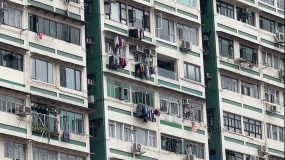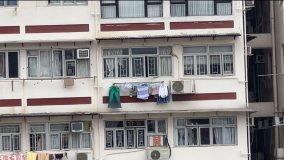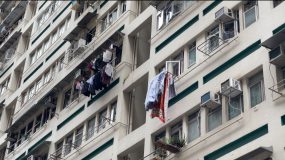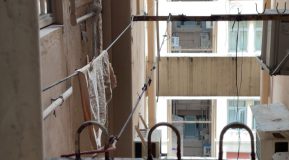CCHU9034 Architecture and Film [Section 2A, 2023]
FIELDWORK REPORT text transcript – Clothes Drying Rack
Yan Chi Hong UID:3035565619 / Ching Hau Sik Monique UID: 3036207525
OPENING :
Hong : In the vibrant city of Hong Kong, there are countless elements that make it truly unique. From space to its traditional buildings, this city is a treasure trove of culture and history. But sadly, in the fast-paced world we live in, many of these elements may no longer exist in just ten short years.
1. What is the artefact that is vanishing?
Hong : Hello and welcome to the podcast! I am Hong, I am Monique. Today we’re going to talk about a common sight in Hong Kong that is both practical and sustainable but that is going to vanish: the traditional Hong Kong drying rack.
Monique: The Hong Kong drying rack, also known as a bamboo pole or bamboo scaffold, is a clever solution to the challenge of drying clothes and other items in a densely populated urban environment where space is limited.
Hong : The rack consists of two long bamboo poles that are supported by metal brackets, and several horizontal bamboo slats that can be used to hang clothes and other items for drying. The poles are typically hung outside of apartment windows or on rooftops, creating a unique visual landscape in the city.
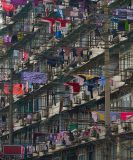
Monique: But the Hong Kong drying rack is more than just a way to dry clothes. It’s also a symbol of sustainability, as it uses natural materials that are renewable and biodegradable. And by hanging clothes to dry instead of using a dryer, people can save energy and reduce their carbon footprint.
2. Why is it vanishing? How do we know that it will no longer exist in the near future?
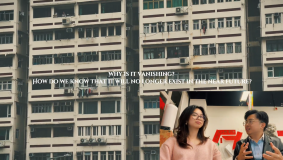
Monique: Hong Kong is notoriously known for its nano-apartments, where storage space is very limited. Finding room for essentials is a challenge, let alone accommodating a laundry drying rack. For that reason, drying racks have been expanded towards the outsides of apartments’ windows. However, there has been a steep decline in the appearance of these drying racks due to many factors, which we will discuss together: One key reason is Hong Kong’s rapid urbanisation and modernization. Where older and more traditional buildings are torn down to make way for modern skyscrapers and complexes. Additionally, advancements in technology have led to the replacement of tedious clothing hanging tasks with the convenience of drying machines. Other factors include health and safety concerns. There have been instances of drying racks collapsing, posing fatal risks to residents and pedestrians below, as well as issues of water dripping that raise concerns about community awareness and the image of the city.
3. What do we know about its past and present? i.e. What purpose/s does it serve?

Hong : Public housing clothes drying facilities have long been criticized. Prior to 2005, most of the older public housing estates used the “Three Incense Sticks” pole-style drying rack, which required residents to lean out of windows to hang their clothes. This led to tragic accidents where individuals lost their balance and fell to their deaths. In response to this issue, the Housing Department has implemented three replacement programs for the drying racks over the past decade. However, each improved version of the drying racks introduced has faced criticism, with some public housing residents claiming that the facilities are impractical. As a result, residents still struggle with the issue of clothes drying on a daily basis.
Monique: Oh that is very tragic.
Hong : In 2004, the Housing Department subsidized residents to replace their drying racks. However, residents were required to pay 200 HKD for the arrangement of stainless-steel drying racks installed by appointed contractors. This measure received mixed responses from residents, and the program had an overall negative response, resulting in the replacement of only 40 thousand drying racks. Ten years later, in 2014, the Housing Department allocated 500 million HKD for a voluntary replacement program, providing free installation of drying racks on the external walls of living rooms. However, these racks faced similar criticism, as they could only hold four pieces of clothing and were installed outside kitchen windows, making them liable to cooking fumes. Consequently, many residents abandoned these racks. This led many residents to install clothes drying poles in their living rooms at their own expense, which might not comply with safety regulations. In 2017, the Housing Department allocated nearly 400 million HKD to install a unified clothes drying pole system in approximately 300 thousand units. Unfortunately, the design received negative feedback, and the expenditure of public funds failed to meet the needs of residents.
Monique: That is really interesting! I have also been doing some research on the drying rack regulations and found a disturbing news report. Apparently in 2022, A 66-year-old woman in Ho Man Tin who was hanging clothes onto the laundry rack outside the window, slipped and fell through the window from her home on the fifth floor.
Hong : Yes, that is very sad to hear.
4. Who will be affected when it no longer exists? What are their feelings and attitudes toward this?
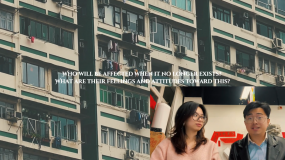
Monique: Thanks for the question! For many long-time residents, the tradition of drying racks exists beyond its functionality; instead, it has been ingrained within their everyday life. Ultimately contributing to a sense of belonging and identity. The disappearance of drying hangers due to urbanism and modernization contributes to the sense of placelessness. This will drastically change the economy as Hong Kong’s urban landscape becomes increasingly homogenised, losing its sense of place and, therefore, influencing businesses as well as tourism.
5. What is being done about its impending disappearance?
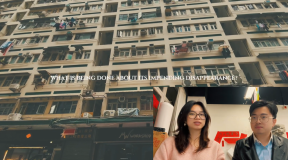
Hong : A very good question! What actions can we take regarding the imminent disappearance of the clothes drying rack I will summarise it into three aspects: The first is to promote more public awareness and understanding of the history and cultural significance of clothes drying racks in education. Understanding the history and importance of traditional drying racks can help us uncover the face of old Hong Kong, and then understand the daily routines of the general public in the 1950s and 1960s, as well as their living habits such as clothing, food, housing, and transportation. This knowledge can be passed on to our descendants, ensuring that they know that the bustling scene of Hong Kong originated from the step-by-step construction of the old people. The second is to record its appearance, usage methods, and structure. Because it is impossible to continue retaining the drying rack, which is limited by Hong Kong’s legislative policy, traditional drying racks will gradually disappear from our sight. But we can use photos, videos, and written descriptions to record this historical data and share it with others. This way, it can be passed down from generation to generation in another form. The third is to visit other places or countries to reminisce about the design of this clothes drying rack. Because in some areas of China, such as Long Gang District in Shenzhen and Taiwan Province, traditional drying racks continue to be preserved, and three incense designed drying racks have also appeared in present-day Singapore, Malaysia, and other places. In this way, our next generation can still continue to learn about the design of clothes drying racks, and through visiting other places, we can recall and savour the scenery of Hong Kong’s old era.
ENDING:
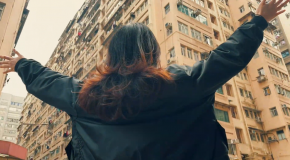
Monique: Indeed, Hong Kong is a city full of vitality, with countless different elements, colours, political spectra, and uniqueness, constantly filled with a rapidly changing rhythm. But under this ever-changing city, what will no longer exist in just ten years? What can we keep? What new challenges will Hong Kong face? We don’t know, perhaps this can only wait for us to slowly adjust in the future.
5 stills photos from the video:
